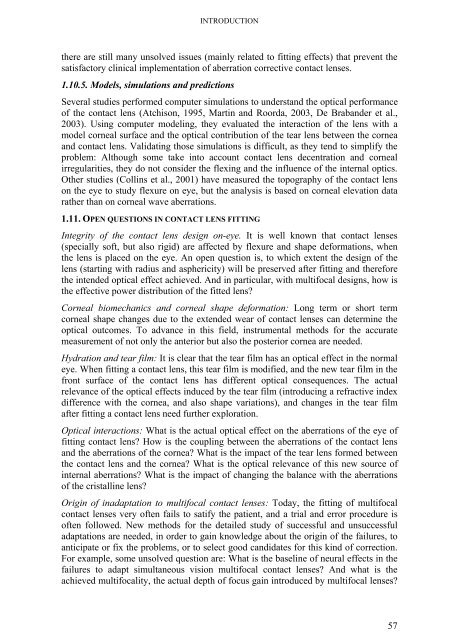Low_resolution_Thesis_CDD_221009_public - Visual Optics and ...
Low_resolution_Thesis_CDD_221009_public - Visual Optics and ...
Low_resolution_Thesis_CDD_221009_public - Visual Optics and ...
Create successful ePaper yourself
Turn your PDF publications into a flip-book with our unique Google optimized e-Paper software.
INTRODUCTION<br />
there are still many unsolved issues (mainly related to fitting effects) that prevent the<br />
satisfactory clinical implementation of aberration corrective contact lenses.<br />
1.10.5. Models, simulations <strong>and</strong> predictions<br />
Several studies performed computer simulations to underst<strong>and</strong> the optical performance<br />
of the contact lens (Atchison, 1995, Martin <strong>and</strong> Roorda, 2003, De Brab<strong>and</strong>er et al.,<br />
2003). Using computer modeling, they evaluated the interaction of the lens with a<br />
model corneal surface <strong>and</strong> the optical contribution of the tear lens between the cornea<br />
<strong>and</strong> contact lens. Validating those simulations is difficult, as they tend to simplify the<br />
problem: Although some take into account contact lens decentration <strong>and</strong> corneal<br />
irregularities, they do not consider the flexing <strong>and</strong> the influence of the internal optics.<br />
Other studies (Collins et al., 2001) have measured the topography of the contact lens<br />
on the eye to study flexure on eye, but the analysis is based on corneal elevation data<br />
rather than on corneal wave aberrations.<br />
1.11. OPEN QUESTIONS IN CONTACT LENS FITTING<br />
Integrity of the contact lens design on-eye. It is well known that contact lenses<br />
(specially soft, but also rigid) are affected by flexure <strong>and</strong> shape deformations, when<br />
the lens is placed on the eye. An open question is, to which extent the design of the<br />
lens (starting with radius <strong>and</strong> asphericity) will be preserved after fitting <strong>and</strong> therefore<br />
the intended optical effect achieved. And in particular, with multifocal designs, how is<br />
the effective power distribution of the fitted lens<br />
Corneal biomechanics <strong>and</strong> corneal shape deformation: Long term or short term<br />
corneal shape changes due to the extended wear of contact lenses can determine the<br />
optical outcomes. To advance in this field, instrumental methods for the accurate<br />
measurement of not only the anterior but also the posterior cornea are needed.<br />
Hydration <strong>and</strong> tear film: It is clear that the tear film has an optical effect in the normal<br />
eye. When fitting a contact lens, this tear film is modified, <strong>and</strong> the new tear film in the<br />
front surface of the contact lens has different optical consequences. The actual<br />
relevance of the optical effects induced by the tear film (introducing a refractive index<br />
difference with the cornea, <strong>and</strong> also shape variations), <strong>and</strong> changes in the tear film<br />
after fitting a contact lens need further exploration.<br />
Optical interactions: What is the actual optical effect on the aberrations of the eye of<br />
fitting contact lens How is the coupling between the aberrations of the contact lens<br />
<strong>and</strong> the aberrations of the cornea What is the impact of the tear lens formed between<br />
the contact lens <strong>and</strong> the cornea What is the optical relevance of this new source of<br />
internal aberrations What is the impact of changing the balance with the aberrations<br />
of the cristalline lens<br />
Origin of inadaptation to multifocal contact lenses: Today, the fitting of multifocal<br />
contact lenses very often fails to satify the patient, <strong>and</strong> a trial <strong>and</strong> error procedure is<br />
often followed. New methods for the detailed study of successful <strong>and</strong> unsuccessful<br />
adaptations are needed, in order to gain knowledge about the origin of the failures, to<br />
anticipate or fix the problems, or to select good c<strong>and</strong>idates for this kind of correction.<br />
For example, some unsolved question are: What is the baseline of neural effects in the<br />
failures to adapt simultaneous vision multifocal contact lenses And what is the<br />
achieved multifocality, the actual depth of focus gain introduced by multifocal lenses<br />
57











